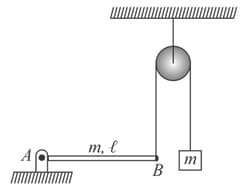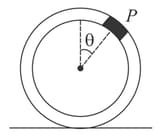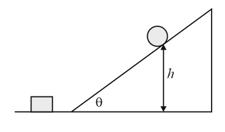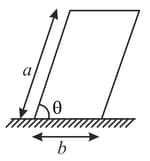Uniform rod is hinged at the end in a horizontal position as shown in the figure (the hinge is frictionless, that is, it does not exert any friction force on the rod). The other end of the rod is connected to a block through a massless string as shown. The pulley is smooth and massless. Masses of the block and the rod are same and are equal to Acceleration due to gravity is The tension in the thread and angular acceleration of the rod just after the release of block from this position.



Important Questions on Rotational Motion
A small block of mass is rigidly attached at to a ring of mass and radius . The system is released from rest at and rolls without sliding. The angular acceleration of the ring just after release is

A spherical rigid ball is released from rest and starts rolling down an inclined plane from height as shown in the figure. It hits a block at rest on the horizontal plane (assume elastic collision). If the mass of both the ball and the block is and the ball is rolling without sliding, then the speed of the block after collision is close to

(take )
Two masses are moving perpendicular to the rod of mass with velocities as shown in the figure. The length of the rod is . Find the ratio of the final velocity of the rod and its angular velocity if the masses stop at their place after collision.

A uniform cube of mass and side is placed on a frictionless horizontal surface. A vertical force, is applied to the edge as shown in figure. The normal reaction effectively acts at a distance,

A homogenous block having its cross-section to be a parallelogram of sides and (as shown) is lying at rest and is in equilibrium on a smooth horizontal surface. Then for acute angle :

